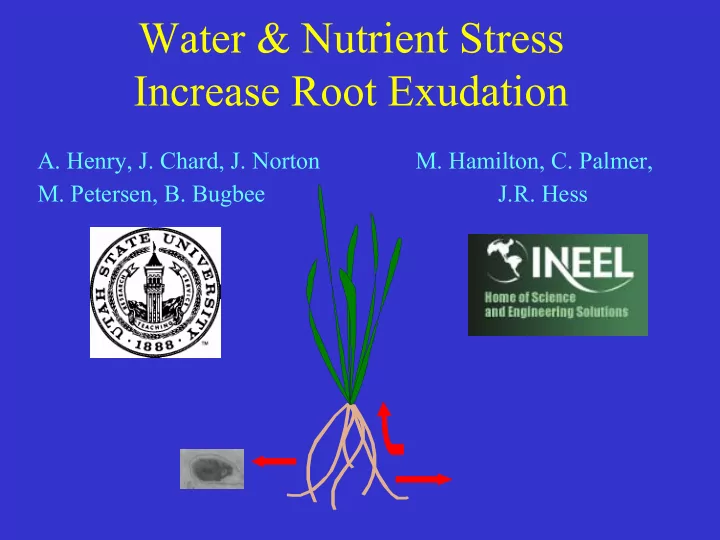

Water & Nutrient Stress Increase Root Exudation A. Henry, J. Chard, J. Norton M. Hamilton, C. Palmer, M. Petersen, B. Bugbee J.R. Hess
Objectives Develop procedures to: • Grow healthy plants under sterile conditions • Manipulate root exudation with stress • Quantify total organic carbon in exudates • Determine composition of exudates using GC-MS
Implications for Phytoremediation Our focus for the qualitative analysis: organic acids The chelating properties of these compounds can be useful for phytoremediation, and they are a class of compound most likely to be found in root exudate Increased plant uptake Increased/decreased Co-metabolism contaminant mobility
Foam plug System for sterile Ground- glass joint culture Septum Air filter Ottawa sand Silicone stoppers Amber vial
HPS lamps Laminar flow hood
Treatments � High NH 4 + � K + stress � Drought � Flooding
100 Trial 6 improved planting technique 80 Trial 3 % Sterile Plants in growth chamber 60 Trial 5 enclosed shoot 40 Trial 4 in laminar flow hood 20 0 0 5 10 15 20 25 30 35 40 45 50 55 60 65 Days After Planting
Assessing microbial contamination
Verifying Plate Counts: Acridine Orange Stain of Leachate Clean sample Root debris 10 µ m
Verifying Plate Counts: Acridine Orange Stain of Leachate Contaminated sample 10 µ m bacteria
Phenolic Aniline Blue Stain of Root Clean root 10 µ m
Phenolic Aniline Blue Stain of Root Contaminated root 10 µ m bacteria
Treatment Averages 1000 The K+ stressed plants had the highest amount of carbon exuded at any point in time. We think this is because the plants were releasing a compound to sequester K+ from the soil. µ g C exuded per day 800 K + stress Treatments 600 started flood 400 drought 200 control + treatment NH 4 0 20 30 40 50 60 70 days after planting
Cumulative carbon exuded per gram dry plant mg C exuded per g dry plant Percent of control Average Std. dev. control 2.6 0.4 2.3 90 0.1 NH4+ 3.7 144 K+ 0.6 145 3.8 flood 0.9 drought 4.4 170 0.5
Primary types of exudates Compounds released by roots Sloughed-off cells
Distribution of Carbon Rhizosphere 17 % sand 9 % Bulk sand Leachates 63 % Soluble 11 % Insoluble 100 % Based on the distribution of carbon released by the roots (mostly soluble with not much left on the sand), we conclude that the exudates we’re seeing are mostly compounds released directly from the root, not whole cells released from the root.
Unlike the TOC graph, organic acids were exuded in the largest GC-MS Data: Exudates amounts from the drought and flooding treatments. This may be due to buildup of osmotic 10 10 potential to deal with the low Fumaric Acid Malonic Acid Concentration (mg/L) Concentration (mg/L) water potentials in the drought 8 8 treatment, or just leakier root drought cells due to the stress 6 6 treatments. 4 4 control flood K+ stress control drought NH4+ trtmt 2 2 K+ stress NH4+ trtmt flood 0 0 30 35 40 45 50 55 60 65 70 30 35 40 45 50 55 60 65 70 Days after planting Days after planting 10 10 Succinic Acid Oxalic Acid Concentration (mg/L) Concentration (mg/L) 8 8 6 6 drought flood 4 4 drought control K+ stress flood K+ stress control 2 2 NH4+ trtmt NH4+ trtmt 0 0 30 35 40 45 50 55 60 65 70 30 35 40 45 50 55 60 65 70 Days after planting Days after planting
What’s in the root vs. what’s released by the root 12 14 Fumaric Acid Succinic Acid 12 10 Exudate (mg/L) Exudate (mg/L) r 2 = 0.54 r 2 = 0.55 10 8 8 6 6 4 4 2 2 0 0 0 500 1000 1500 2000 0 100 200 300 400 500 Root (mg/kg) Root (mg/kg) 6 12 Oxalic Acid Malonic Acid 5 10 Exudate (mg/L) Exudate (mg/L) r 2 = ns r 2 = ns 4 8 3 6 2 4 1 2 0 0 0 20 40 60 80 100 120 0 50 100 150 200 250 300 350 400 Root (mg/kg) Root (mg/kg)
Treatment Averages Conclusions 1000 800 K + stress µ g C exuded per day 600 flood 400 drought 1. Stress increases root 200 control + treatment NH 4 0 exudation. Drought and 20 30 40 50 60 70 days after planting flooding treatments increased 10 release of organic acids. Succinic Acid Concentration (mg/L) 8 6 drought 4 K+ stress flood control 2 2. Concentrations of succinic and NH4+ trtmt 0 30 35 40 45 50 55 60 65 70 fumaric acid in the root Days after planting correlated with amounts 14 Succinic Acid released by the root. 12 Exudate (mg/L) r 2 = 0.55 10 8 6 4 2 0 0 100 200 300 400 500 Root (mg/kg)
Recommend
More recommend